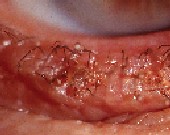 |
 |
A healthy 20-year-old female presents complaining of a unilateral, irritated, itchy eyelid and lash area. Her symptoms are especially intense following a hot shower. She reports that she has had these symptoms for about four months and has tried several over-the-counter and home remedies to no avail.
Gross inspection of her lid reveals blepharoconjunctivitis and a pruritic lid margin. Upon detailed biomicroscopic examination, however, you note not lash scaling, but ruptured and unruptured egg sacs. You also see an oval, crab-like organism in the lower lash region; the organism is clutching onto the cilia with its claws.
Upon rolling and partially everting the upper eyelid, you now see approximately two dozen live organisms. Thus, your diagnosis is quite clear: crab louse infestation of the ocular adnexathe topic of this months column.
Three Forms of Crab Louse
There are three major lice that infest humans: Pediculus humanus capitis (head louse), Phthirus pubis (crab louse) and Pediculus humanus (body louse).1 Eyelid infestation is almost always attributed to Phthirus pubis.
When Phthirus pubis infestation occurs on the eyelids, we use the term Phthiriasis palpebrarum. Phthiriasis palpebrarum is an uncommon and easily overlooked cause of blepharoconjunctivitis.2-5
 |
| Phthiriasus palpebrarum ruptured and unruptured egg sacs. |
Pediculus is also a 2 to 4mm-long organism with a broad-shaped, crab-like body, though its legs are thinner than those of Phthirus. Pediculus typically resides and lays eggs in the hair on a persons head. Once it has found a home, it can adhere to the chosen hair shaft or move from person to person via close contact with an infested individual or contaminated bedding. This form of louse is also associated with crowding or poor personal hygiene.1
Infestation of the cilia by this creature, however, is rare and only occurs in the worst cases. Therefore, we will only address the ocular signs, symptoms and management of Phthiriasus palbebrarum.
The ocular signs and symptoms of Phthirus infestation include visible organisms on the eyelashes, visible blue skin lesions (louse bites), reddish-brown deposits (louse feces), secondary blepharitis with preauricular adenopathy, follicular conjunctivitis and, in severe cases, marginal keratitis. The patient with Phthirus often presents with bilateral ocular itching and irritation. Superinfection of bites can lead to preauricular gland swelling.3-5
Mechanical Removal
Many doctors advocate the mechanical removal of the organisms and the organisms eggs.2-4 You can do this at the slit lamp using jewelers forceps. Then, dip the lice in alcohol to kill the removed organism.
During this procedure, the organism will hold tenaciously to the eyelashes. As a result, many eyelashes will be inadvertently epilated, making the process quite uncomfortable for the patient.
Consider applying an ophthalmic ointment, such as topical bacitracin, to make the removal less painful. Ointments make the actual removal of these organisms easier, as the creatures will not be able to clutch as tightly to the lashes. However, grasping the organisms may be more difficult due to the lubrication of the ointment.
Chemical Management
We can also manage Phthiriasis palpebrarum chemically. Here are the four chemical treatments currently available:
Bland topical ophthalmic ointments. An ophthalmic ointment, such as an antibiotic ointment, applied b.i.d. for two weeks will smother the organisms. The antibiotic may also protect against bacterial infection from the creatures bites.
Pediculocides, such as yellow mercuric oxide N.F. 1% ophthalmic ointment or physostigmine ointment 0.25%. Local application of either one of these, b.i.d. for a minimum of two weeks, will kill Phthiriasis palpebrarum.5 Physostigmine, an anticholinesterase drug formerly used to treat glaucoma, and mercuric oxide poison the organisms respiratory system.
Still, ongoing treatment (single applications for up to two weeks) is required with any ophthalmic ointment. Thats because the thriving organisms will survive a single application, and their hatching eggs can cause reinfestation.
A single application of 20% fluorescein to the eyelid. This method requires no sedation or anesthetic, and you can do it as an outpatient procedure. Also, 20% fluorescein is nontoxic and not irritating.6
Medicated shampoo. Medicated shampoos, such as Rid, are safe and effective, nonprescription pediculo-cides that can rid the patient of Phthiriasis palpebra-rum. Due to their ocular toxicity, however, patients should not use these products on their eyelashes. Rather, patients can use them to treat other infested hair regions. These shampoos simply impede the migration of the organisms. Again, due to the toxicity of these shampoos, they should be used with caution.
Our treatment of choice is the mechanical removal of all organisms and as many of the eggs as possible, followed by topical antibiotic ointment treatment b.i.d. for two weeks. We also recommend disinfecting clothing, linen and personal items with heat of 122F for 30 minutes.5
When faced with a patient such as the one mention-ed above, you must also consider concurrent infection and other sexually-transmitted diseases, such as HIV, syphilis and Chlamydia. In fact, pubic lice infestation can be predictive of a concurrent Chlamydia infection in adolescents.7 Refer such patients to be screened for other STDs, such as gonorrhea.7
If, however, you are faced with a young child who has this condition, he or she may be the victim of sexual abuse. Therefore, you should report the incident according to your state law.
1. Ko CJ, Elston DM. Pediculosis. J Am Acad Dermatol 2004 Jan; 50(1):1-12.
2. Yoon KC, Park HY, Seo MS, Park YG. Mechanical treatment of phthiriasis palpebrarum. Korean J Ophthalmol 2003 Jun;17(1):71-3.
3. Ikeda N, Nomoto H, Hayasaka S, Nagaki Y. Phthirus pubis infestation of the eyelashes and scalp hairs in a girl. Pediatr Dermatol 2003 Jul-Aug;20(4):356-7.
4. Lin YC, Kao SC, Kau HC, et al. Phthiriasis palpebrarum: an unusual blepharoconjunctivitis. Zhonghua Yi Xue Za Zhi (Taipei) 2002 Oct;65(10):498-500.
5. Couch JM, Green WR, Hirst LW, de la Cruz ZC. Diagnosing and treating Phthirus pubis palpebrarum. Surv Ophthalmol 1982 Jan-Feb;26(4):219-25.
6. Mathew M, DSouza P, Mehta DK. A new treatment of pthiriasis palpebrarum. Ann Ophthalmol 1982 May;14(5):439-41.
7. Pierzchalski JL, Bretl DA, Matson SC. Phthirus pubis as a predictor for chlamydia infections in adolescents. Sex Transm Dis 2002; June 29(6):331-4.

